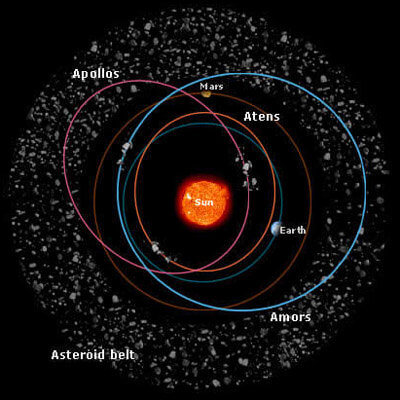Minor Planets
Our Solar System is composed of eight planets and their satellites, an asteroid belt between the orbit of Mars and Jupiter, the Trojan asteroids in Jupiter’s L4 and L5 Lagrange points, comets, and Kuiper Belt objects (also known as Trans-Neptunian Objects). The majority of these comets, asteroids and the Kuiper Belt objects are known as minor planets.

Most asteroids reside in the Main Belt between the orbits of Mars and Jupiter. However, some asteroids, as well as comets, have been nudged by gravitational interactions with the planets into orbits that cause them to enter Earth’s neighborhood. Asteroids and comets on orbits that come closer to the Sun than 1.3AU (the distance from the Earth to the Sun is equal to 1 astronomical unit or AU) are generally referred to as Near Earth Objects (NEOs). Several sub-groups have been identified:
- Apollo population: Earth-crossing NEOs with semi-major axes larger than the Earth’s.
- Aten population: Earth-crossing NEOs with semi-major axes smaller than Earth’s.
- Amor population: Earth-approaching NEOs with orbits exterior to Earth’s but interior to Mars’.
- Atira population: NEOs with orbits entirely interior to the Earth’s.

As of mid 2014, more than 11,000 NEOs have been discovered, and currently there are 1,500 objects that have been classified as Potentially Hazardous Asteroids (PHAs). A PHA is an NEO that can approach the Earth at a distance of 0.05 AU or less and whose size is bigger than about 150 meters (490 feet).
Why study minor planets?
Minor planets, such as comets, asteroids, and satellites provide important information about the formation and evolution of the Solar System. Several techniques, such as spectroscopy, and photometry, can be used to study these objects. Spectroscopy helps to determine compositions of objects, whereas photometric study provides information about rotational properties and shape (or surface heterogeneity). Astrometry is also needed to constrain orbits and to understand dynamical evolution scenarios.


